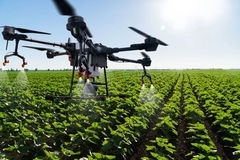Safeguarding Pollinators Is the Key to Crop Protection, Says New Research
15 Aug 2016 --- New types of insecticides, the expansion of corporate agriculture and emerging viruses, are some of the biggest threats to pollinators, says a new study.
The research, which has been published in award-winning open access publisher for biomedical sciences PeerJ, identified the most serious threats to pollinating species. But it also details some of the opportunities for pollinators to provide essential agricultural and ecological services around the world.
The study was carried out by an international group of scientists, government researchers and NGOs led by Professor Mark Brown from the Royal Holloway University of London and was funded by SuperB, an EU-supported network.
After identifying such changing and increasingly challenging risks to species likes bees, other insects, birds and mammals, the research team is calling for a type of future proofing for the world’s most important pollinators.

They believe there should be global policies of proactive prevention, rather than reactive mitigation to protect the future survival of these vital species.
“The homogenization of agriculture effectively means that corporations are applying blanket production systems to landscapes that are vastly different, significantly reducing the diversity and number of native pollinators,” explained Sarina Jepsen, Director of Endangered Species and Aquatic Programs, The Xerces Society and Deputy Chair, IUCN Bumblebee Specialist Group.
During the research, a method of horizon scanning was used to identify future threats that need preventative action as well as opportunities that should be taken advantage of in order to protect the pollinators that are vital to wildflowers and crops.
“35% of global crop production, and 85% of wild flowering plants rely on hard-working pollinators to thrive. We are increasingly adopting practices that damage these species. Then, we rather absurdly look to mitigate their loss, rather than prevent it in the first place,” says Professor Brown.
“This is an expensive and back-to-front solution for a problem that has very real consequences for our well-being. Most research focuses on the battles already being fought, not on the war to come.”
Out of a total 60 identified risks and opportunities, the research team shortlisted six priority issues, including: Corporate control of agricultural at the global scale, new emerging viruses, increased diversity of managed pollinator species, effects of extreme weather due to climate change, reduction in chemical use in non-agricultural settings and sulfoximine, a novel systemic class of insecticides
The research also draws attention to the consolidation of the agri-food industries as a major potential threat to pollinators, claiming that a small number of companies now have “unprecedented control of land.”
For example, the rise in transnational land deals for crop production includes large areas of Brazil used for soybean export to China which currently total 40 million hectares.
Professor Brown is keen to point out the positives from the research.
“However, it is not all doom and gloom. For example, such global domination provides an opportunity to influence land-management to make it favorable for pollinators at huge scales, but this would require the agri-food industry to work closely together with NGOs and researchers.”
The study also found positive opportunities for pollinators. For example, the current and future reduction of chemical use in non-agricultural land, gardens and parks, could be fruitful for pollinating populations.
“We must continue to encourage these practices across industry, government, and the public, so that we give our important pollinating species the support they need to do their vital work,” added Professor Brown.
The research’s co-author, Lynn Dicks from the Department of Zoology at the University of Cambridge, believes much work can be done right now to protect pollinators, but it involves working closely with big business.
"Identifying environmental issues in advance, before they become large scale, allows society to plan responses and reduce environmental risks before they are upon us. It is a routine part of strategic planning in financial management, and it should also be routine in environmental planning and policymaking. Many of the pollinator issues we identified on the horizon can be responded to right now, for example by working with corporations already controlling large areas of agricultural land to develop pollinator management strategies, or by planning research on the sub-lethal effects of sulfoxaflor before it is widely used."











